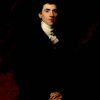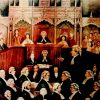Brougham Place in North Adelaide is named after Lord Brougham, otherwise known as Henry Peter Brougham, 1st Baron Brougham and Vaux, Lord High Chancellor of the United Kingdom between 1830 and 1834.
He was nominally a Whig member of the House of Lords, although he was much more outspoken and more radically inclined than most of his contemporaries. At the time of the passage of the South Australia Act in 1834 he was almost certainly in support of the measure. However, by 1837, at about the time the streets of Adelaide were named, the zenith of his parliamentary career had begun to wane, the Whigs lost power and he retreated to the House of Lords to gather the remnants of his shattered dream. Brougham’s opportunity to become Prime Minister had evaporated.
At the fall of Wellington’s Tory government in November 1830 the Whigs came to power under the leadership of Lord Grey. Althorp was their leader in the House of Commons. Brougham, who is best described at the time as a headstrong mercurial polymath with an independent streak of radical genius, also coveted the premiership. But he was not really a team player and sometimes a little bit mad; a characteristic not conducive to good stable government.
However, as a man of the people and a champion of the underdog he couldn’t be left out of the ministry. Grey sought a means to include him in Cabinet, while at the same time precluding him from challenging for the prime ministership. Brougham was firstly offered the attorney generalship, but in a fit of pique he stamped it into the floor. Prime Minister Grey responded with what can only be described as a stroke of Machiavellian genius. He offered Brougham the Lord Chancellorship, a position he couldn’t really refuse. In one stroke this removed Brougham to the House of Lords and into one of the highest offices in the land. As Lord High Chancellor, the second highest appointment possible, he was assured of a seat in Cabinet, a peerage, and the roles of Presiding Officer in the Lords and head of the judiciary throughout all of England and Wales. Such prominence may of itself have been sufficient reason for Brougham to be given a place on the streets of Adelaide.
There are many reasons why the name Brougham reposes on the high ground in North Adelaide, where it overlooks the Parklands and the spire of St Peter’s Cathedral. Brougham was a household name in Britain throughout the 1820s and 1830s. He had a hand in everything. His capacity for work, his legal acumen, his passion for reform, his mountains of publications and the diversity of his interests are legendary. He was a member of the literati, a statesman, an orator – who still holds the record for the longest speech in the House of Commons – at six hours – an advocate for the oppressed and a man of diverse learning in the sciences, the arts, law and economics. In effect he was a juggernaut.
All members on the Street Naming Committee would have known this and been in awe of him, even if one or two of them might not have sympathised with his politics. A Whig he might have been, but in reality he was more like a patrician overlooking the Philosophical Radicals without being counted among their number. Brougham led from the front in a host of radical causes. His was a persona at least as influential and as memorable as Jeremy Bentham or John Stuart Mill or even James Mill, who was for many years one of his closest associates.
Lord Brougham’s most widely known achievements include prominence in the abolition of the slave trade, especially in connection with a Bill which made slave trading a felony in 1811. He was co- founder of and prolific contributor to the Edinburgh review from 1802. He gained legal notoriety in his celebrated defence of Queen Caroline in a case where her husband, George IV, attempted to sue her for adultery and to remove her royal title in 1820. He showed prominence in the call for parliamentary reform in 1832 and prompted legal and judicial reform as exemplified in the erasure of judicial power in the Privy Council in 1833.
Brougham showed initiative associated with reforms in education and the formation of London University in 1836 and was responsible for the widespread distribution of children’s educational material, especially of a scientific nature. He was also responsible for the introduction of the Married Women’s Property Bill, which passed into law as the Matrimonial Causes Act 1857. Brougham supported the emancipation of Jews in the House of Commons. He became Chancellor of Edinburgh University in 1859.
A lesser-known and comparatively obscure fact about him with an Adelaide connection might also include his design of a four-wheeled, single horsedrawn carriage, which he invented in 1838. Somewhat remarkably, this vehicle is where General Motors Holden drew inspiration for the Holden Brougham, an elite six-cylinder family sedan manufactured in South Australia between 1968 and 1971.
Brougham was entirely familiar with the works of Adam Smith, which prompted his first treatise in 1803; a substantial work entitled An inquiry into the colonial policy of the European powers. He criticised Smith’s economic theory on colonial policy and summarised the colonial policies of the Spanish, English, French and colonial governments. He was for the most part a proponent of free trade, although he thought David Ricardo’s economic system seemed to be so oversimplified that he must have ‘descended from some other planet’.
Brougham’s literary career flowered profusely thereafter and for the next sixty years extended to hundreds of publications and mountain of correspondence. Fortunately much of this has been preserved. The library of University College London have in their keeping 60,000 items of his correspondence and ninety boxes of miscellaneous material, including all of his manuscripts and other family documents. For decades Lord Brougham must have been one of the busiest men alive.
In 1826 he began the Society for the Diffusion of Useful Knowledge (SDUK), of which he was Chairman, the organisation that published academic papers on general knowledge and matters of educational, technical and scientific interest. Through an associated but inexpensive tract known as The Penny magazine, which he made available to both middle- and working-class children, it was Brougham’s ambition to reach the masses, giving all the means to improve their lives. The newly conceived Mechanics’ Institutes and the new London University, both of which he was partly responsible for, were initiatives designed to excite further interest in learning. They became conduits for the educational improvement of young men, and later young women throughout Britain.
He was a Fellow of The Royal Society, where it is presumed he was known to other Fellows like Thomas Fowell Buxton MP, John George Shaw Lefevre, and Charles Kemeys Kemeys Tynte MP – all men who had some association with the South Australia project.
Perhaps the two most likely members of the Street Naming Committee to advance the name of Brougham would have been either Robert Gouger or James Hurtle Fisher, or perhaps both. Fisher was known to have appealed personally to Brougham for an appointment on the Poor Law Commission. He didn’t get that job but not long afterwards was appointed Resident Commissioner for the new colony. Gouger too was known to Brougham through his work as Secretary of the Parliamentary Candidates Society, where he was essentially working for Francis Place (the radical tailor of Charing Cross) and, indirectly, the great Jeremy Bentham.
Despite Brougham’s overwhelming popularity among the public, many on his side of politics were not so keen on the idea of him taking the lead, for fear of his aggressiveness on the floor of the House, his excesses and his lack of personal discipline. Ironically, in some respects Brougham was more a conservative than a radical, but this might easily be attributed to a generational difference between him and the many young and impressive politicians of the time. Nevertheless, the causes he espoused were always clothed in the need for change and he could never be accused of trying to defend the status quo.
The four cornerstones of his outstanding 1830s campaign were to: drastically revise the Corn Laws so as to reduce the exorbitant cost of bread; abolish the remainder of the East India Company’s trade privileges; demand a speedy extinction to colonial slavery to the cheers of the Yorkshire Quakers, Methodists and non-conformists; and to introduce moderate measures of parliamentary reform encompassing a Triennial Act and the enfranchisement of all inhabitant householders.
He personally believed in and supported the South Australian colonising initiative. Through his SDUK the colonists were most pleased to receive a donation of a number of books for a library in Adelaide.
However, there is one breathtaking irony to all this, and that is the prosecuting role which Brougham played in the criminal case which saw Edward Gibbon Wakefield imprisoned for the abduction of 15-year-old heiress Ellen Turner. Wakefield might have been the architect of systematic colonisation, but were it not for his three-year detention in Newgate Prison it is highly improbable he would have had sufficient steadiness and/or persistence to produce such a brilliant thesis. Henry Brougham was at the time (in 1826) at the height of his legal career and known by all in Britain for his celebrated legal defence of Queen Caroline against the King.
In this case against the Wakefields, for more than one in the family was indicted for conspiracy and abduction, Brougham was on the prosecuting panel. The trial was conducted over two days at Lancaster Assizes, where Wakefield had been detained in the castle for four months. After evidence had been taken from a dozen or so witnesses, including the headmistress of Ellen Turner’s school in Manchester, the jury returned a verdict of guilty.
Lord Brougham was born in the busiest part of Edinburgh, near the corner of West Bow and Cowgate, on 19 September 1778. For someone so bright and so precocious it was a tremendous advantage because Edinburgh was flowering culturally as never before. It was the intellectual hub of Britain in the late-eighteenth century. Adam Smith, David Hume and an advanced educational system gave Brougham a very good start in life. At age 7 he was already in high school and six years later graduated top of his class. At 14 he entered Edinburgh University and by 1796 was sufficiently advanced to have one of his papers accepted by The Royal Society, before becoming a Fellow of that esteemed institution at the tender age of 25. His topic reflected his early interest in science and mathematics.
Two years’ study in civil law followed and in 1800 he was formally admitted to the faculty of advocates. He and a small group of friends including Reverend Sydney Smith, Francis Jeffrey and Francis Horner founded the highly successful Edinburgh review, which ran for decades and became the literary mouthpiece for the Whig party throughout the land and the western world.
As one might expect, Lord Brougham moved easily among the chattering classes. However, Michael Lobban says that he was slightly uncomfortable in the company of women. There were several women in Brougham’s life. He had a fling with Lady Caroline Lamb in 1816. She was the wife of William Lamb, the 2nd Viscount Melbourne and Prime Minister by 1835, which might account for Brougham’s omission from Cabinet in that government.
In 1819 Brougham did settle to marriage, some say rather unexpectedly, when he took Mary Ann Spalding, the daughter of Thomas Eden of Wimbledon, as his wife. They had two daughters, the first dying in infancy and the second, Eleanor Louise Brougham, who also died rather sadly at the age of 17 in 1839. The despair that Brougham must have felt at the loss of Eleanor at a time when his personal popularity and hope of becoming prime minister was fading accounts for the uncharacteristic withdrawal from the limelight and his deep depression, which became noticeable in the House of Lords during this period.
His wife Mary Ann was uncomfortable in the public eye and timidly avoided the literati. She apparently remained a sickly and anxious woman who never really shared in Brougham’s rather extravagant lifestyle. Ensconced in their London home and out of the limelight, ‘[h]er health degenerated progressively, and by the 1840s her hypochondria had developed into total mental breakdown. She died in January 1865’.
Henry Brougham was a tall, lanky man with distinguishing physical characteristics which set him apart from most. His nose especially drew much comment, for it was much larger than most other Anglo Saxon noses. Unsurprisingly, this made him an easy target for caricature.
In the parliament Lord Brougham could hardly sit still for a moment. He had an opinion on almost any issue, and given the breadths and plumbing depths of his mind he was wont to speak much more than most. He rarely missed a sitting, and even in the depths of an English winter he would remain in the benches until the last.
Brougham always regretted being transferred to the Lords. His presence there totally undermined his intentions and for the remainder of his parliamentary career he carried some bitterness. He was at his best in opposition in the Commons, where he could canvas the most obscure issues and regale everyone with them ad nauseam. He advocated every human right and viciously exposed every human wrong. He unearthed an unending catalogue of injustices and swept them up for attention: the intolerable weight of the tax laws; excise duties and the associated scourge of smuggling; the price of gold; and oppressive game laws, to name a few.
In 1835 Brougham accidently discovered the small seaside township of Cannes, which at that time was little more than an isolated fishing village with an amenable climate. He fell in love with it and would frequently retreat there to write and relax. He spent the last thirty years of his life in the House of Lords. So it was not surprising that as his candle began to dim he more frequently retreated to what has now become such a fashionable holiday setting. Under a warm sun he would sit and write capaciously for publications like the Edinburgh review. However, his best work can be found in his Sketches of statesmen who flourished in the time of George III and in the four-volume set of his own speeches, which he completed in 1838. His final work was a somewhat grandiose autobiography, which was published posthumously.
On 7 May 1868, the man who was known as the living encyclopedia and who regaled his audiences with long, passionate sentences passed from this life. He was just short of his 90th birthday and was buried in Cannes.







Comments